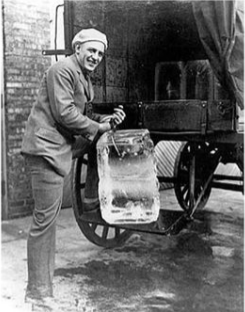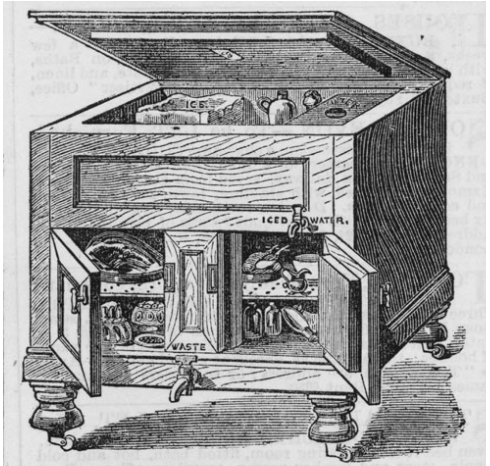An icebox (also called a cold closet) is a compact non-mechanical refrigerator which was a common early-twentieth-century kitchen appliance before the development of safely powered refrigeration devices. Before the development of electric refrigerators, iceboxes were referred to by the public as “refrigerators”. Only after the invention of the modern-day electric refrigerator did the early non electric refrigerators become known as an icebox.
The icebox was invented by an American farmer and cabinetmaker named Thomas Moore in 1802. His first design consisted of an oval cedar tub with a tin container fitted inside with ice between them, all wrapped in rabbit fur to insulate the device Later versions would include hollow walls that were lined with metal and packed with various insulating materials such as sawdust or straw A large block of ice is held in a tray or compartment near the top of the box. Cold air circulates down and around storage compartments in the lower section. Some finer models have spigots for draining ice water from a catch pan or holding tank. In cheaper models, a drip pan is placed under the box and has to be emptied at least daily. The user has to replenish the melted ice, normally by obtaining new ice from an “iceman”.

The constant underground temperature of 54 °F has been utilized in preserving ice collected during winter months in the form of underground pits for a long time. Prior to the convenience of having refrigeration inside the home, cold storage systems would often be located underground in the form of a pit. These pits would be deep enough to provide thorough insulation and also to deter animals from intruding on the perishable items within.

By the year 1781, personal ice pits were becoming more advanced. Advanced pits contained a drainage system for water runoff as well as the use of brick and mortar for its insulation. An octagon-shaped pit, approximately 12 ft in diameter located 15 ft underground was capable of storing ice that was obtained during the winter months to the next October or November. Ice blocks collected during winter months could later be distributed to customers. As the icebox began to make its way into homes during the early to mid-19th century, ice collection and distribution expanded and soon became a global industry.

Recent Comments